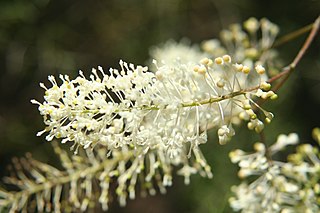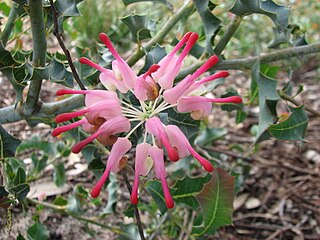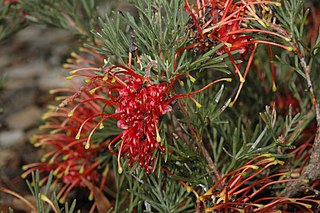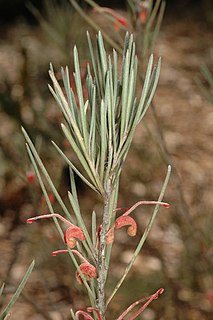
Grevillea leptopoda is a species of flowering plant in the family Proteaceae and is endemic to the south-west of Western Australia. It is a spreading to erect shrub with divided leaves, the lobes further divided, the end lobes linear, and clusters of white to cream-coloured flowers.
Banksia montana, commonly known as the Stirling Range dryandra, is a species of shrub that is endemic to the Stirling Range in Western Australia. It has hairy stems, linear pinnatisect leaves with twisted, triangular lobes, yellow flowers in heads of about sixty and reddish-brown follicles.

Grevillea humifusa, commonly known as spreading grevillea, is a species of flowering plant in the family Proteaceae and is endemic to a restricted area of the south-west of Western Australia. It is a prostrate shrub with long, trailing stems, divided lives with linear lobes and clusters of pink to pale red and cream-coloured flowers with a reddish, yellow-tipped style.

Grevillea asparagoides is a species of flowering plant in the family Proteaceae and is endemic to the south-west of Western Australia. It is dense, prickly shrub with deeply divided leaves, the end lobes linear and sharply pointed, and pink to reddish flowers with red styles.

Grevillea candicans is a species of flowering plant in the family Proteaceae and is endemic to the south-west of Western Australia. It is a bushy shrub with pinnately-divided leaves with sharply-pointed linear lobes, and cream-coloured flowers.

Isopogon sphaerocephalus, commonly known as drumstick isopogon or Lesueur isopogon, is a species of plant in the family Proteaceae and is endemic to the south-west of Western Australia. It is a shrub with linear to narrow egg-shaped leaves and spherical heads of hairy white to creamy yellow flowers.

Grevillea acropogon is a species of flowering plant in the family Proteaceae and is endemic to a restricted part of southwestern Western Australia. It is a prostrate to erect shrub with pinnatisect leaves with five to seven sharply-pointed lobes, and red flowers.

Grevillea maccutcheonii, commonly known as McCutcheon's grevillea, is a species of flowering plant in the family Proteaceae and is endemic to a single location in the south-west of Western Australia. It is a densely-branched shrub with three-lobed, stem-clasping leaves, and clusters of reddish-green flowers. The total population of the species was estimated in 2007 to be seven mature plants.

Grevillea aspera, commonly known as the rough grevillea, is a species of flowering plant in the family Proteaceae and is endemic to Australia, occurring mainly in South Australia. It is low, spreading to erect shrub with oblong to egg-shaped leaves with the narrower end towards the base, and pinkish to red and cream-coloured, green, yellow or white flowers.

Grevillea christineae, commonly known as Christine's grevillea, is a species of flowering plant in the family Proteaceae and is endemic to the south-west of Western Australia. It is an erect, rounded shrub with wiry branches, linear to narrowly elliptic leaves, and white flowers.

Grevillea leucoclada is a species of flowering plant in the family Proteaceae and is endemic to a small area in the west of Western Australia. It is a shrub with divided leaves, the lobes further divided, the end lobes linear or tapered, and cone-shaped clusters of white to cream-coloured flowers.

Grevillea insignis, commonly known as wax grevillea, is a species of flowering plant in the family Proteaceae and is endemic to the south-west of Western Australia. It is an erect, bushy shrub with more or less oblong leaves with seven to seventeen sharply-pointed, triangular teeth, and more or less spherical or cylindrical clusters of cream-coloured flowers ageing to pink.

Acacia volubilis, also known as tangle wattle, is a shrub belonging to the genus Acacia. It is native to a small area in the Wheatbelt region of Western Australia. It has been declared endangered under the Commonwealth Environment Protection and Biodiversity Conservation Act 1999.

Grevillea brachystylis, also known as short-styled grevillea, is a species of flowering plant in the family Proteaceae and is endemic to the south-west of Western Australia. It is a low, spreading to erect shrub with linear to narrow egg-shaped leaves with the narrow end towards the base, and wheel-like clusters of hairy red flowers.
Grevillea brachystylis grandis, commonly known as large-flowered short-styled grevillea, is a subspecies of Grevillea brachystylis.
Grevillea calcicola is a species of flowering plant in the family Proteaceae and is endemic to the north-west of Western Australia. It is a much-branched shrub with pinnatisect leaves with linear lobes, and off-white to cream-coloured flowers.

Grevillea costata is a species of flowering plant in the family Proteaceae and is endemic to the west of Western Australia. It is a spreading shrub with sharply-pointed, linear leaves and white flowers.

Grevillea delta is a species of flowering plant in the family Proteaceae and is endemic to restricted area in the south-west of Western Australia. It is a bushy, spreading shrub with hairy branchlets, divided leaves with linear lobes, and groups of red flowers with a red, green-tipped style.

Grevillea haplantha is a species of flowering plant in the family Proteaceae and is endemic to the south-west of Western Australia. It is a dense, rounded shrub with linear leaves and clusters of pink to red flowers with white or brown hairs, depending on subspecies.
Grevillea pythara, also known as the Pythara grevillea, is a shrub of the genus Grevillea native to a small area in the Wheatbelt region of Western Australia.

















